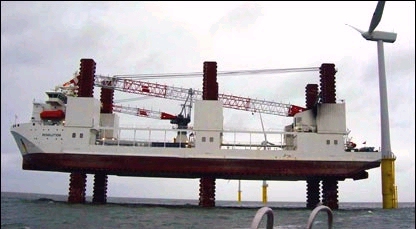Submitted by Charles Frost on Sun, 02/03/2008 - 21:39.

Rising from stormy seas, the giant turbine towers of an offshore wind farm seem almost miraculous to the untrained eye. But how do you put them there?
Most boats do not have legs. But a jack-up barge has six, protruding high into the air when the ship is in transit.
Extending to a length of 48m from the bottom of the ship, and penetrating up to 5m into the sea bed, the "legs" of these ships provide a stable "ground" in a place where there is only roiling water.
As the legs push down, the ship is lifted above the waves. Purpose-built at a Chinese shipyard, the £60m jack-up barge MPIO Resolution is an extraordinary piece of engineering in itself.
With a solid platform achieved, the windmill is fixed into place using a crane from the ship.
These procedures are becoming more common as the drive goes on to increase wind power.
If government targets are to be met, the UK could have as many as 7,000 offshore wind turbines by 2020. In the process, it would increase the amount of energy produced by that means about 60-fold.
The building of each offshore site tends to be contentious, with complaints about disruption to wildlife and eyesores.
And after surmounting any planning concerns, the big engineering question of putting the turbines in place remains.
The giant jack-up barges are purpose-built for the expanding industry and one such vessel is the £60m MPIO Resolution.
Its most recent appointment has been to help with construction of the 60-turbine Robin Rigg scheme in the Solway Firth, about six miles off the south west coast of Scotland.
In August last year, the £325m scheme's progress was delayed by the late arrival of another jack-up barge, the Lisa A.
Then 38 workers had to be rescued from Lisa A after it started to list dangerously. It was taken to Belfast to undergo checks and the Resolution was drafted in.
The barge itself is a major piece of construction to overcome the difficulties of working at sea.
The vessel was purpose-built at the Shanhaigun Shipyard in China and delivered to the UK in February 2004.
On average, it takes about 24 to 36 hours to install wind turbine foundations from a vessel like the Resolution.
At locations where drilling is required, it can taking closer to three days.
Then the vessel often has to wait for high water to allow it to move to the site of the next turbine.
Finally, it can return to fit the rest of the structure - usually in a period of about 24 hours for each turbine.
E.ON, the company behind the Robin Rigg project, has been philosophical about the difficulties encountered in the Solway.
"The offshore environment does present a number of challenges that you don't face onshore," said a company spokesman.
"However, offshore wind does offer a number of advantages such as the potential to build larger and more powerful wind farms.
"Certainly the availability of vessels capable of carrying out offshore work is an issue.
"And there's always the possibility that bad weather and high seas can affect construction, but the more we learn about building these projects the easier it will become."
Offshore wind farms like Robin Rigg play a key role in helping the UK deliver its renewable energy targets, E.ON believes, and in teaching lessons for the next generation of bigger, more powerful wind farms.
Which may mean we see more massive jack-up barges patrolling the waters around the UK in years to come.
From: http://news.bbc.co.uk/2/hi/uk_news/magazine/7206780.stm
WHAT IS THE RESOLUTION'S BEAM/HEADROOM?
The casson foundations in the photo above where placed by Bauer.
And I assume Bill you were thinking about Lake Erie?
Welland Canal...
Beam/headroom?
1,000 Wind Turbines In Lake Erie?
Jeff,
I was just saying that if indeed "they" are planning on putting 1,000 wind turbines up in Lake Erie, (http://www.realneo.us/about-realneo/is-there-gold-in-that-there-lake) "They" might want one (or more) of these.
"You" were discussing practical considerations...
"They" are talking "Big Money" (read "Big Profits").
"They" have "Little People" who's job it is to worry about the little things like putting a square peg in a round hole. (or a 125' beam ship in a 100'canal)...
I only hope that "They" also have "Little People" who are interested in creating a wind manufacturing industry (read jobs) here in Northeast Ohio, rather than importing all the pieces and parts from Germany, China, Pennsylvania, Kentucky, and other "foreign" locations.